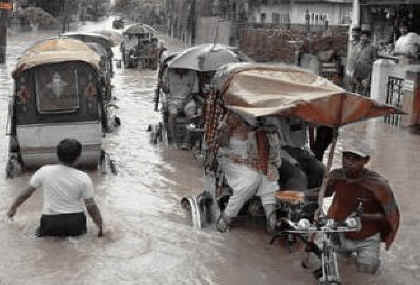Scientists predicted monstrous flood in India six months ago
Dead bodies of humans and animals can still be seen in muddy waters running through the streets of the city

Various sources estimate damage caused by record-breaking rains in India at a range between $700 million and $900 million. The death toll is nearing 1,000. Total number of people affected by the disaster exceeds 20 million. Heavy rains started pouring over Maharashtra state a week ago. Officials say parts of Mumbai, formerly known as Bombay, have been hit by more than 250 millimeters of rain by Tuesday, the highest level of precipitation in India's history. 
Officials call on local residents to stay home. Schools in the state are shut down again. However, thousands of people filled the streets protesting belated actions of the government. The population is angry at the authorities because they did not take necessary steps to prevent the spread of potential diseases in the area. Dead bodies of humans and animals can still be seen in muddy waters running through the streets of the city. Some residents say electricity has been down for 5 days in the central parts of Mumbai, a city regarded as India's financial capital.
According to meteorologists, rains are not expected to let up soon in Maharashtra state.
Earlier this year scientists forecast an upcoming calamity in India. In March scientists said that India, China, and Nepal might be hit by strong floods due to the thawing of the snow in the Himalayas. Scientists also predicted that deadly droughts would follow the floods. Jennifer Morgan, director of Global Program for Protection from Climate Change, warned the public of the disaster. The World Wildlife Fund (WWF) also warned of the consequences of the Himalayas glaciers' fast melting. The Himalaya Mountains has the world's second largest reserves of fresh water after the glaciers in the North and South Pole.
According to specialists, the water levels in the largest rivers of South and South East Asia depend on the state of glaciers. The rivers include Ganga, Indus, Brahmaputra, Mekong, Yangtze River, and Huang He. The decrease of ice at the mountain tops is currently 10-15 meters a year. The rivers will become shallow in the next few decades following the floods. As a result, the regional population will suffer from a lack of fresh water. Besides, the water level fluctuations will disrupt the operations of large hydroelectric power plants. Consequently, a recession will hit the economies of the region.
The above changes are largely due to economic activity. According to a forecast, Earth's climate will be getting warmer year in and year out even if the human race pulls the plug on poisonous emissions. Average temperatures of the environment are expected to rise by 1 degree Celsius by the year 2100. The world ocean's average water levels will increase by 11 centimeters. Scientists anticipate a significant increase in the amount of poisonous gases to be emitted in the atmosphere in the near future. The increase will be caused by new production facilities.
Complete thawing of ice and snow at the top of Mount Kilimanjaro was the most frightening sign of global warming. The ice and snow at the mountain top melted away for the first time for the last 11 thousand years. The phenomenon happened earlier than predicted. Scientists forecast the thawing of ice and snow at Mount Kilimanjaro for 2020. Meanwhile, India may have to face yet another threat.
Geologist David Montgomery at the University of Washington discovered a number of things while conducting a research in Tsangpo, a river gorge in Tibet. He found out that massive lakes had existed in the gorge at the different stages of history. Those lakes disappeared without a trace when enormous volumes of water swept them away into the lowlands. The Tsangpo River flows across a mountainous area located at 4,000 meters above the sea level, it is the highest-altitude river in the world. The river goes steeply down and becomes the full-blown Brahmaputra as it reaches India.
Mr. Montgomery's study shows that the Tsangpo gorge was completely blocked by ice several times in the past and therefore water stopped flowing down and kept filling the giant lake for centuries. Then the ice dam broke and all the water from the lake came crushing down into the lower part of the gorge and farther on to the plains of India. The developments brought about some of the worst floods in history of humankind.
The latest catastrophe took place about 1,500 years ago. The lake was 235 meters deep at the time of disaster. More than 200 cubic kilometers of water rushed down at the instant. Another catastrophe of a larger scale occurred 10,000 years ago. The maximum depth of the lake was 600 meters at the time. The amount of water in the lake exceeded 2,000 cubic kilometers.
Andrey Polyakov
Subscribe to Pravda.Ru Telegram channel, Facebook, RSS!


